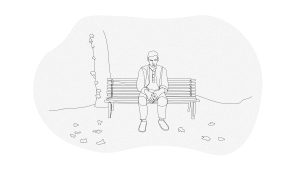One day around five years ago, Arben stopped in front of a residential building across from Prishtina’s City Park and looked up toward the balcony of the first floor where the offices of the Kosova Rehabilitation Center for Torture Victims (KRCT) are located.
Just take a deep breath, he thought, walk a few steps, knock on the door and that would be it — an end to two decades of isolation.
Arben, who is in his late thirties, approached the door while trying to put order to the words in his head. He hadn’t yet decided whether to introduce himself with his real name or a pseudonym.
He looked around the unfamiliar neighborhood and at the unknown faces passing in the street who took no notice of him. He was far from his village, but he was terrified that someone might recognize him, that his secret would be revealed (Arben is a pseudonym, granted to protect his privacy).
Then he panicked. He ran into the park, sat on the first bench he came across, waited for his rapid heartbeat to slow down, and returned home.
After a few months he tried again. The same scene unfolded: cold sweat on his forehead, trembling and shaking, his heart racing, an escape to the same bench and back to the village.

On his third try he finally made it inside the center’s doors.
Once inside, he shared with the center’s staff the story of being raped by a Serbian paramilitary member during the Kosovo War in spring 1999 when he was 17 years old. It was the only time he had told anyone besides his parents and siblings.
Arben’s house is just off the main street of a village that saw some of the worst atrocities during the war. He witnessed neighbors and relatives die, houses turned into rubble and day and night explosions and shelling.
Houses near the main streets tended to be the first targets for attack so Arben’s family found temporary shelter in a house around a kilometer away where a dozen people hid together and shared the little porridge that Arben’s mother made from what wheat she could mill in a coffee grinder. Besieged by troops from all sides, they soon ran out of food.
“We were so exhausted and scared, waiting to die, either from Serbian forces, or from hunger,” Arben said. “Then all the wheat was gone.”
Eventually, a wave of silence spread across the village one day. Arben took advantage of the lull to go to the family house and collect sacks of wheat to bring back to the group. Once inside he heard a crashing sound. Two paramilitary members burst into the house and shoved Arben to the ground where he fell onto the sacks of wheat. Then one of the men raped him.
Arben was aware that rape was used against women and girls. He had seen Serbian forces coming at night to take them from their houses and returning them in the early morning naked and covered in bruises.
But, he said, “I never imagined that this could be done also to men.”
For a long time, Arben was convinced he was the only man to have been a victim of sexual violence. Before he started attending therapy sessions at KRCT he didn’t have the words to describe what had happened to him or how to make sense of it.
Arben is one of 67 men, according to the latest data taken from the Government Commission on Recognition and Verification of the Status of Sexual Violence Victims, who are legally recognized by the state as wartime victims of sexual violence. The state has so far granted the status to 1,305 women.
Wartime sexual violence
Sexual violence in war is nothing new, but awareness of its use as a weapon of war is. This understanding emerged out of the feminist movements of the 1970s, which argued that rape isn’t a crime driven by sexual desire, but a tool men use to exert power and dominance. Although women and girls are the predominant victims of sexual violence in war and in peace, the idea of rape as an act of dominance helps explain the occurrence and motives behind the rape of men and boys in war settings.
War rape and other forms of sexual violence are tools to disempower and humiliate the victim (of either gender) as well their families and communities, particularly in cultural settings where patriarchal chastity norms or ideas of masculinity are enforced. When carried out systemically or openly, it has the further effect of creating a sense of fear and vulnerability among potential victims.
From the early days of the war in Kosovo, testimonies began to emerge from Kosovar women in refugee camps about gang rapes committed by Serbian forces. The estimate is that in Kosovo between 1998 and 1999, as many as 20,000 people were raped. In the immediate aftermath of the war, organizations like Human Rights Watch tied the systematic nature of the crimes to the broader strategy of the Milošević regime to ethnically cleanse Kosovo of Albanians.

Arben said that when he told his father about being raped, his father replied, “I am happy you are alive son. They could have killed you. They did this to others and then they killed them.”
He was never sure if his father’s words came from actually hearing stories or from a heartbroken father trying to console his traumatized son. Since Arben was never arrested or taken into custody, and the rape occurred in his own house with no witnesses, he never heard of or saw other men being sexually abused.
Arben hid his traumatic experience from his mother and siblings for a long time. He made sure they wouldn’t find his anxiety medication or antidepressants; he always snuck outside to take his pills.
“Each time I went outside, I thought, ‘It is better to just kill myself,'” he said. “Then during the night I had the same nightmare every night. Them… doing that. Every morning I woke up in so much sweat, like someone threw water on me. I went to sleep wishing I would die, and woke up every single day with that wish.”

Stories like Arben’s are at the center of a soon-to-be released research project conducted by KRCT and the University of Leuven in Belgium.
“The research suggests that sexual violence as a weapon of war is directed toward everybody, although only women were perceived as a target traditionally,” said Feride Rushiti, the executive director of KRCT. “But reports globally show that men and children are also targets.”
In 1998 and 1999, Rushiti was working with international missions in Albania where she interviewed women at refugee camps who had survived sexual violence in Kosovo. Sources told her about the prevelance of sexual violence in detention centers and prisons where Albanian inmates, almost all of whom were men, had been illegally detained, beaten and tortured.
She was aware at the time of sexual violence against men and boys that occured during dictatorships or wars in Chile, El Salvador, Greece and across former Yugoslavia. What was unclear was how common this crime was.
Some research indicates sexual violence against men can be extremely high in cases of war or conflict. In El Salvador, 76% of male political prisoners researchers spoke to reported experiencing some form of sexual torture. Of male concentration camp detainees held in a camp near Sarajevo during the Bosnian War, 80% acknowledged suffering some form of sexual abuse.
Rushiti’s familiarity particularly with nearby Bosnia and the sexual violence that occurred there during the war meant she was more or less certain that some Kosovar Albanian men and boys had become victims. Years before the first reports from male survivors made their way to KRCT, she and her staff were careful to always use gender-neutral terms in their public and private statements as an organization to not imply that only women were victims.
Then in 2018, KRCT and other organizations that work with survivors of wartime sexual violence started hearing more stories of sexual violence against men.
Starting that year, survivors of war-related sexual violence became eligible to apply for the status of victims through a government Verification Commission, which entitles victims to a 230 euro monthly pension. This official recognition, and the financial support, encouraged dozens of men to tell their stories and request help at victims’ organizations. The number of female survivors approaching the organizations also increased.

The government’s Verification Commission was established in 2017 and began work the following year. Composed of nine representatives from the government and civil society, the commission assesses applications for official status as a wartime victim of sexual violence. It will run until February 2023.
“The fact that the state recognizes your pain and validates your past, it detaches you a bit from the swirl of trauma and it puts you in a different position,” Rushiti said.
Veprore Shehu, executive director of Medica Kosova, an organization based in Gjakova that works with survivors, noticed the effects of the state support.
“From an emotional and psychological point of view, this state recognition makes you understand that what happened wasn’t your fault, and that the state recognizes this violence as a tool and strategy of war,” she said.
So far, around 50 men have come forward to KRCT as survivors of sexual violence. More than 10 have come forward at Medica Kosova and around 20 at Medica Gjakova, another Gjakova-based organization that works with survivors.
“First comes the recognition and then they acknowledge the need for psychological support,” said Selvi Izeti, a psychologist at KRCT.
Helping survivors
The International Criminal Court recognizes rape, sexual slavery, forced prostitution, forced pregnancy, forced sterilization or abortion, sexual mutilation and sexual torture as forms of sexual violence.
Sexual violence carried out against men in conflict zones can take many forms. There is oral or anal rape, sometimes committed with an object, as well as forced sterilization, such as castration or other types of sexual mutilation. There is also forced nudity (often accompanied by threats or mockery), forced masturbation and genital violence, which may include electric shocks or blunt force trauma to the testicles or penis.
Medica Kosova’s Shehu says that the majority of men who seek psychological and social support from her organization suffered a combination of at least two types of abuse — often rape and genital beatings.
The youngest male survivor of wartime sexual violence that KRCT psychologist Izeti has worked with is a man who was 11 years old when he was violated. He was taken together with his mother and held at a house where they were both raped. Later, Serbian forces mutilated the boy’s genitals. Medica Gjakova is aware of a separate incident where a mother and son were both held captive and raped.
“The oldest [survivor] I work with currently is around 70 years,” said Shpresa Frrokaj, a psychologist at Medica Gjakova. “Imagine an old man who is retired and talks about it for the first time in his life. I am the only one that he has talked to. He never mentioned anything to anybody.”
The psychologists and researchers K2.0 spoke with agree that one of the reasons that sexual violence against men and boys went unreported for so long is that many of the organizations dealing with survivors of sexual violence were established explicitly as women’ rights organizations focused on female survivors. Of the organizations in Kosovo, only KRCT had expertise working with men and their traumatic experiences due to torture.
“We all had to go through additional training after the Verification Commission started working and we had the first male sexual violence survivors coming to ask for help,” Frrokaj said.
An additional issue that allows sexual violence against men to slip through the cracks is that humanitarian workers on the ground working in the aftermath of war have mainly been trained to work with female survivors.
“There is a window of opportunity to speak about in the beginning. And if it doesn’t happen it becomes more difficult,” said Heleen Touquet, a visiting professor at the University of Antwerp and a senior researcher at the University of Leuven who researches sexual violence against men and boys in conflict zones.
She said that humanitarian workers may not register certain types of trauma among men, or may not know to ask men the right questions that would elicit an account of sexual violence. In other cases, male survivors who’ve reached out to a psychiatrist have felt stigmatized because not all professionals have received proper training to deal with them.
Many male survivors of wartime sexual violence in Kosovo had their genitals damaged and were later unable to become parents.
In addition, sexual violence is often classified only as torture. For example, though genital mutilation is a prevalent form of sexual violence that many boys and men suffer in conflict zones, activists and scholars who have worked directly with survivors note that the sexual element of the violence is often overlooked by both humanitarian organizations and victims themselves. Touquet said that many Croatian survivors of sexual violence during the war in the 1990s were hit in the genitals but still referred to it only as torture.
“This is sexual violence, and it has serious consequences for reproductive health,” she said.
According to the organizations K2.0 spoke with, many male survivors of wartime sexual violence in Kosovo who had their genitals damaged by blunt force trauma or electric shocks were later unable to become parents.
Touquet said that violence that results in the purposeful reduction of reproductive capacity for a target group or ethnicity can be seen as “a type of genocidal violence.”
Another common form of sexual violence used by Serbian forces in Kosovo was forcing people to strip naked in public — a type of humiliation that is often not recognized as a type of sexual violence.
“There was that case where a husband and wife were forced to get undressed and stay naked, while the Serbian forces just watched them,” Izeti said. “Or there is this case where a huge number of prisoners were stripped naked in the prison yard.”
Anna De Lellio, a researcher and sociologist who co-authored one of the key studies showing the pattern of sexual violence Serbian forces used systematically alongside mass murder and the burning and pillaging of property, heard a number of stories during her field work of men being stripped naked.
“I was interviewing women from Drenica for another project, they said that in this particular village Serbian troops, before gathering men, forced them to dance naked,” she said. “That is sexual violence. It is humiliating. Then they put men in trucks and they disappeared and were killed.”
She says that these kind of stories illustrate how the crime of sexual violence gets marginalized in the hierarchy of what is the gravest war crime — human loss.
“Men are more vulnerable in war because they get killed. We remember them as killed, but not sexually assaulted. We don’t remember humiliation against the dignity of the person,” De Lellio said.
Sexual abuse in detention
The Bosnian War set a milestone in international justice by officially categorizing rape as a crime against humanity. Not only did it put sexual violence against women and men on the radar of courts and international organizations (resulting in the first ever U.N. investigation into sexual violence against men and boys during the war), it also highlighted that sexual violence occurs frequently in detention centers and prisons.
Meanwhile in Kosovo, the full scale of wartime sexual violence against men and boys is not yet known. Interested parties are waiting until the end of the Verification Commission’s five-year mandate before making a broader conclusion about its prevalence. But what is clear is that similar to in Bosnia, sexual assaults occurred often in detention centers, whether they were prisons, police stations or improvized set-ups. The mental health providers K2.0 spoke with noted that this is the case for more than half the male survivors they work with.
“It is evident that many men were sexually abused during arbitrary arrests and detentions,” Selvi Izeti said.
She gave the example of one survivor she works with who was removed from a column of refugees and held in an improvised detention center inside a store. Packed in among dozens of other men (he told her he counted 99 detainees), he was eventually taken away for interrogation, at which time he was sexually violated.
He never told anyone about the abuse, nor did he see or hear about others getting sexually abused, but Izeti and the man do not believe that he was the only one in the group to undergo the experience.
Some evidence suggests that sexual violence against Kosovar Albanian men and boys at detention centers and prisons predated the war. Based on interviews and research, Touquet has found evidence that Yugoslav police in Kosovo used sexual violence on people at police stations in the 1980s and early 1990s during periods of political unrest.
“You see this dynamic of wanting to suppress this nationalism in Kosovo and then targeting young men, young students and this especially demobilizes them, demotivates them,” Touquet said.
She points to an Amnesty International report from 1993 that includes a medical certificate from Prizren that notes that a man, after being detained by the police, was admitted to the hospital “because of injuries (rupture) to his left testicle inflicted by the blows of a rubber truncheon.” The man later had to have the testicle surgically removed.
“In Kosovo it is quite clear that this belongs to their repertoire of violence — violence that they used before the war, and violence that they used during the war,” Touquet said.
'Sexual violence against political prisoners was systematic.'
Behxhet Shala
K2.0 spoke with three people who were held as political prisoners in the late Yugoslav period about sexual abuse against Kosovar Albanian prisoners. All said they were aware of several men who had been sexually abused in Yugoslav prisons.
“Similar to how the sexual violence was systematic against women during the last war, the sexual violence against political prisoners was systematic as well,” said Behxhet Shala, a former political prisoner and the executive director of the Council for the Defense of Human Rights and Freedoms (CDHRF), a human rights organization founded in 1989 that is Kosovo’s oldest.
Shala says that political prisoners were often stripped naked before days-long interrogations. “It became a normal thing for the political activists,” he said.
In his capacity as executive director of CDHRF, Shala has heard stories of men who were forced into humiliating positions while naked, men who had their genitals beaten or shocked with electricity and men who were raped by other convicts at the order of prison guards.
CDHRF has collected some accounts of men who were sexually abused during the war at the infamous prisons Smrekonica, Lipjan and Dubrave, along with smaller detention centers and police stations.
“Since the war ended we have had a few cases that we talked about here but we didn’t register them because [the victims] didn’t want any record of anything,” Shala said.
‘The only time when I feel like I did before the war’
It was only after 2018 that Bekim first told his story of being sexually assaulted during the war. Like most other men now coming forward, he opened up when he decided to seek help and recognition as a victim of war. Like Arben, he went to the KRCT offices a number of times before he had the courage to finally enter; he remembers it took at least six attempts before he went through with it.
In the spring of 1999, Bekim (a pseudonym) was arrested in his hometown on the charge of collaborating with the Kosovo Liberation Army (KLA) and detained in a police station. While standing in a long line of detainees waiting to be interrogated, two police officers grabbed him and pushed him into a bathroom where one of the police officers raped him.
The same day, he was imprisoned on charges of terrorism. At the end of the war he was transferred to Serbia before being freed by the Yugoslav government in 2001 when Belgrade passed an amnesty bill for several hundred imprisoned Albanians.
“All those prisons and torture, but it was only that day at the police station that I thought about,” he said. “It is nothing when they beat you.”
For the first time in two decades, the therapy sessions at KRCT gave some peace of mind to Bekim and Arben.

“There is an ease when you talk with somebody who knows what you went through, and you are sure that the person won’t talk,” said Bekim.
“Sometimes when I talk about it here and I feel understood,” Arben said, “I feel a sort of short liberation and even comfort. It is the only time when I feel like I did before the war.”
But any feeling of relief is temporary, as the sense of humiliation and anxiety haunts them in their daily lives. The feeling was so strong that Bekim, despite the financial strain, moved to another town after the war out of fear that people around him would find out what happened to him.
Both men deal with self-loathing and intrusive thoughts that pester them in public and the workplace. As a result, both have struggled to hold on to employment.
“When I see two people talking, I immediately think that they are talking about me. That they are mocking me. That they know,” Bekim said. He gets so anxious that he has often departed suddenly and without explanation and then not returned to work for a few days. This tends to result in him being fired.

Bekim’s concern that others might view him with disdain is not simply a response to his trauma; he was familiar with the fact that many female survivors of sexual violence in Kosovo were shunned and abandoned by their husbands and families, belittled and outcast by neighbors and their communities.
“I often heard men talking so badly about women who were raped,” Bekim said. “‘Probably they wanted it too,’ they’d say.”
Though both female and male survivors of sexual violence can experience shame, fear, depression or suicidal thoughts, Izeti’s work with survivors indicates that male survivors of wartime sexual violence are victims of specific gendered stereotypes and pressures. They may be more reluctant than women to speak out about being victimized because it could undermine expectations of masculine strength.
While the women she works with need little time to start talking about their traumatic experiences, men usually dedicate the whole first session to physical torture and avoid sexual violence.
'Men find it harder to look you in the eye. Their identity is threatened by feeling emasculated and feminized.'
Selvi Izeti
“Men only start talking about sexual violence toward the end of first session. It is so hard for them to verbalize it,” she said. “Women look at you directly and talk. The men find it harder to look you in the eye — they turn their eyes to the side, or look down. Their identity as men is threatened by feeling emasculated and feminized.”
Izeti said the difference relates to feelings of blame. The women she works with tend not to blame themselves and understand the violence that occurred as beyond their control. It is society, or families, or husbands or fathers that assign blame to the women and see the women’s victimhood as shameful. The men, however, internalize their shame and feel they are to blame for having been raped or violated, or for not having been able to be “man enough” to protect themselves.
Perpetrators, Touquet said, “use the taboo that exists in society and make people carry shame for the rest of their lives.”
Bekim and Arben say that they’ve felt “less than a man” and “stripped of their manhood” not only in connection to their assaults, but also when their struggles with the subsequent trauma have disrupted their ability to function in normal life — when they’ve struggled to provide for their families, connect with their wives, or be there for their aging parents and their children. Bekim blames himself that his son didn’t pass the university entrance exam.
Despite these challenges, Bekim feels that female survivors of wartime sexual violence have it even worse.
“I believe that men are judged more. But still, I come here [to KRCT] without being asked where I am going, because men usually go out without having to say exactly where we are going,” Bekim said. “Imagine, a woman that comes here, that they need to tell everybody in the family when they step outside. Just imagine how that is for those who cannot even move anywhere. They cannot even ask for help.”
De Lellio says the narrative of the masculine liberation struggle leaves no room for stories that threaten to feminize men.
Touquet has interviewed both civilian and combatant male survivors of sexual violence from all over the world and noticed that veterans find it easier to talk about the experience because their involvement in the war provides them with a masculine narrative of patriotism and self-sacrifice that makes the sexual violence they suffered less threatening to their manhood.
However, she said that the narrative for civilians seemed to be that if “you fled, and you got raped, then you are a [weak] man and there is so much shame.”
In the context of Kosovo, De Lellio says that the narrative of the masculine liberation struggle leaves “no room for vulnerability” or for stories that threaten to feminize men.
De Lellio notes that the Reçak Memorial, commemorating the massacre of 45 Albanians by Serbian forces, was only built recently and has always been in the shadow of the story of Prekaz, where KLA leader Adem Jashari and his family fought to the death against Serbian forces. The dominant narrative is of “resistance until death,” she said, “epic and heroic. Not a story of men being caught and getting killed. Even less a story of men being caught and sexually abused.”
This political and cultural context can condition the ways survivors engage with and process their experiences, Touquet and a co-author argue in a recent paper. Arben and Bekim, for their part, say that they wouldn’t live in silence and isolation if they believed their stories would be heard without condemnation or ridicule.
They ask, Bekim said, only “for people to not mock us, to not look at us with prejudice. Particularly men, because if [men] were understanding like women are, I swear I would go on TV and talk about what happened.”
Feature image and illustrations: Dina Hajrullahu / K2.0.







